Investment in Soft Skills Training: A Report for Unilever Australia
VerifiedAdded on 2023/06/03
|16
|3166
|274
Report
AI Summary
This report assesses the potential benefits of implementing soft skills training at Unilever Australia. It includes a SWOT analysis and PEST analysis of Australia to understand the internal and external factors impacting the organization. The report highlights the advantages of soft skills training, such as relationship enhancement, time management, effective communication, leadership skills development, and stress management. It also outlines the logistics of implementing a soft skills training program, including identifying training needs, defining performance goals, choosing delivery methods, selecting training providers, and tracking success metrics. Finally, the report discusses the value added to Unilever through soft skill training, including increased credibility with customers, more productive employees, and reduced employee turnover. The document is contributed by a student and available on Desklib, a platform offering various study tools for students.
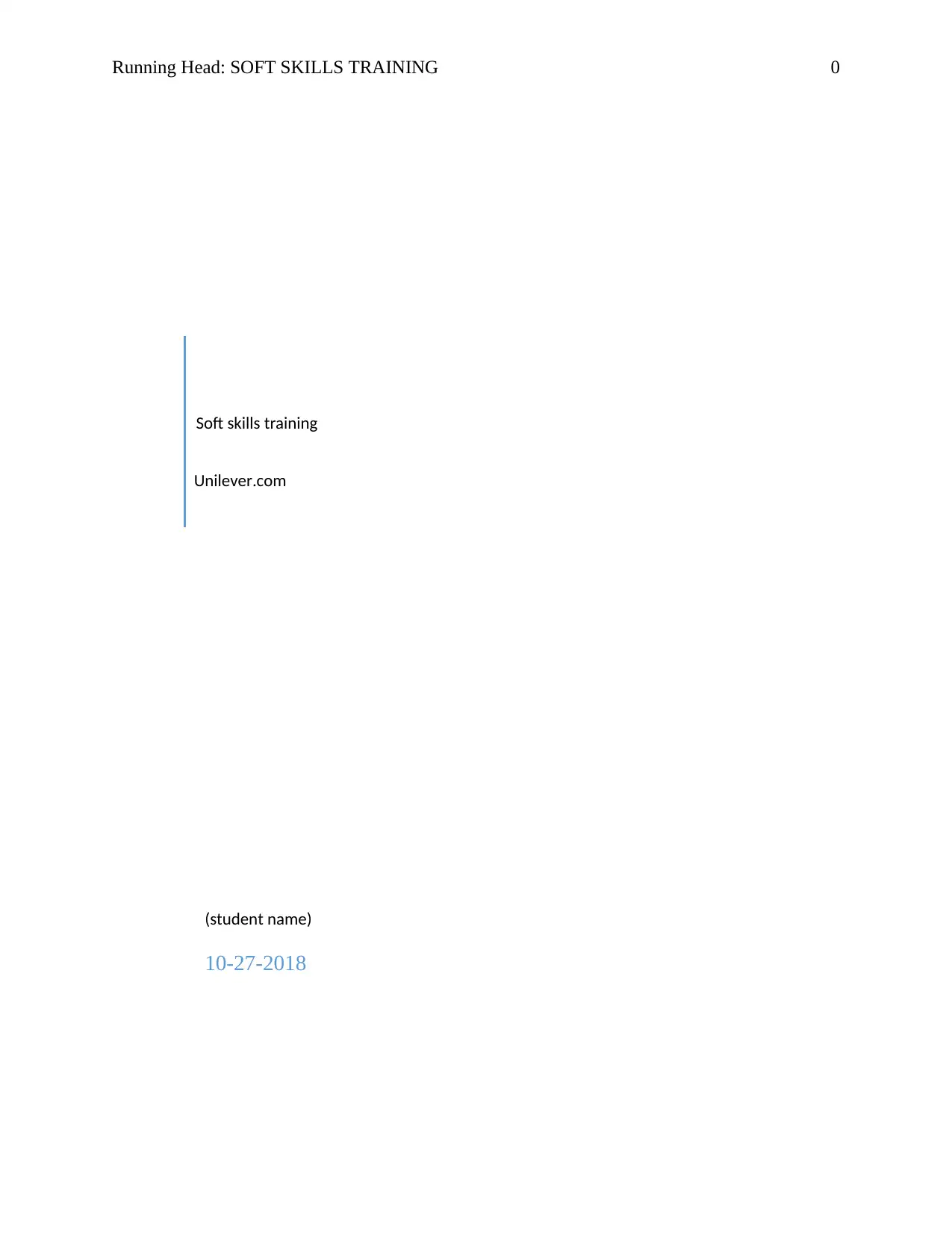
Running Head: SOFT SKILLS TRAINING 0
Soft skills training
Unilever.com
(student name)
10-27-2018
Soft skills training
Unilever.com
(student name)
10-27-2018
Paraphrase This Document
Need a fresh take? Get an instant paraphrase of this document with our AI Paraphraser
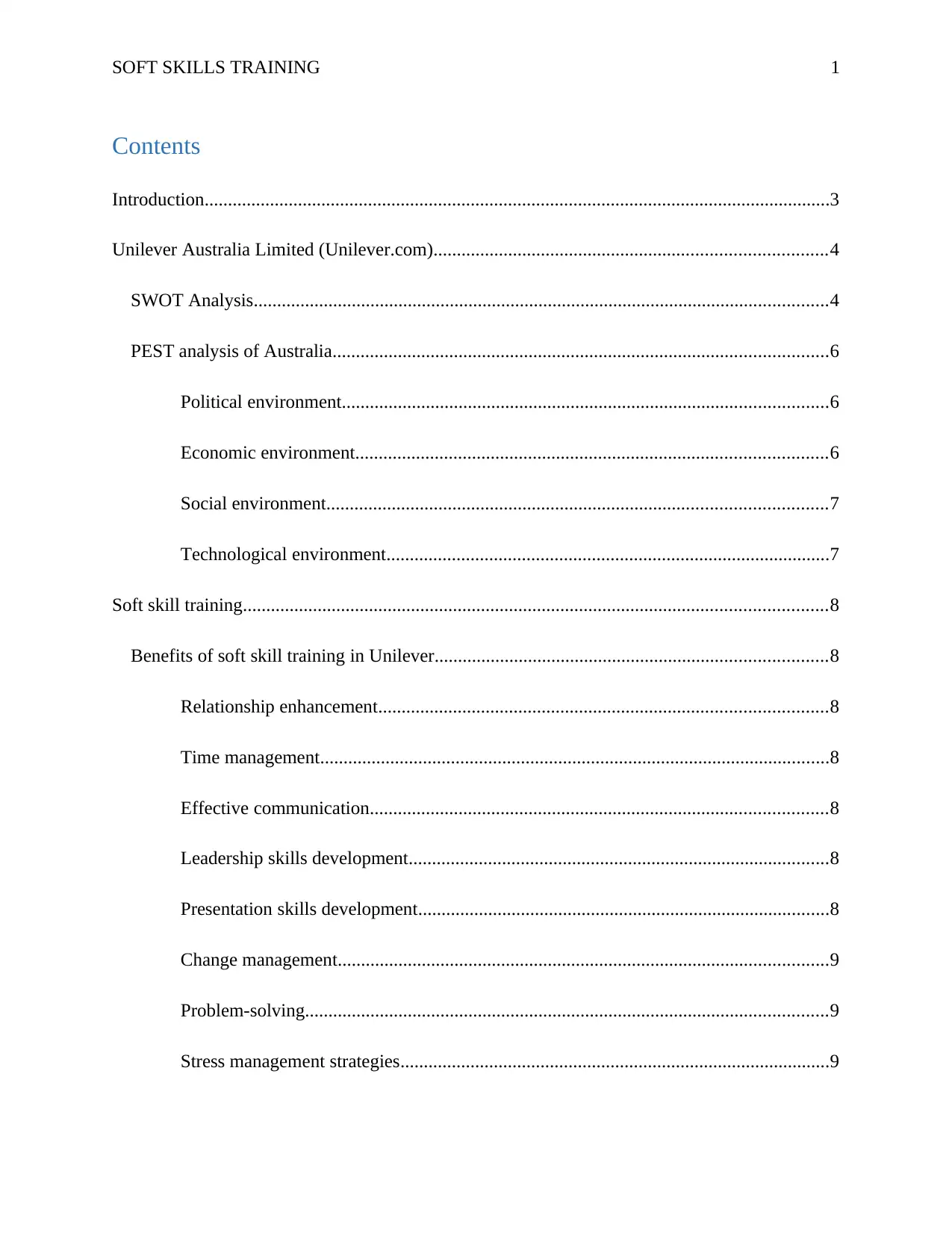
SOFT SKILLS TRAINING 1
Contents
Introduction......................................................................................................................................3
Unilever Australia Limited (Unilever.com)....................................................................................4
SWOT Analysis...........................................................................................................................4
PEST analysis of Australia..........................................................................................................6
Political environment........................................................................................................6
Economic environment.....................................................................................................6
Social environment...........................................................................................................7
Technological environment...............................................................................................7
Soft skill training.............................................................................................................................8
Benefits of soft skill training in Unilever....................................................................................8
Relationship enhancement................................................................................................8
Time management.............................................................................................................8
Effective communication..................................................................................................8
Leadership skills development..........................................................................................8
Presentation skills development........................................................................................8
Change management.........................................................................................................9
Problem-solving................................................................................................................9
Stress management strategies............................................................................................9
Contents
Introduction......................................................................................................................................3
Unilever Australia Limited (Unilever.com)....................................................................................4
SWOT Analysis...........................................................................................................................4
PEST analysis of Australia..........................................................................................................6
Political environment........................................................................................................6
Economic environment.....................................................................................................6
Social environment...........................................................................................................7
Technological environment...............................................................................................7
Soft skill training.............................................................................................................................8
Benefits of soft skill training in Unilever....................................................................................8
Relationship enhancement................................................................................................8
Time management.............................................................................................................8
Effective communication..................................................................................................8
Leadership skills development..........................................................................................8
Presentation skills development........................................................................................8
Change management.........................................................................................................9
Problem-solving................................................................................................................9
Stress management strategies............................................................................................9
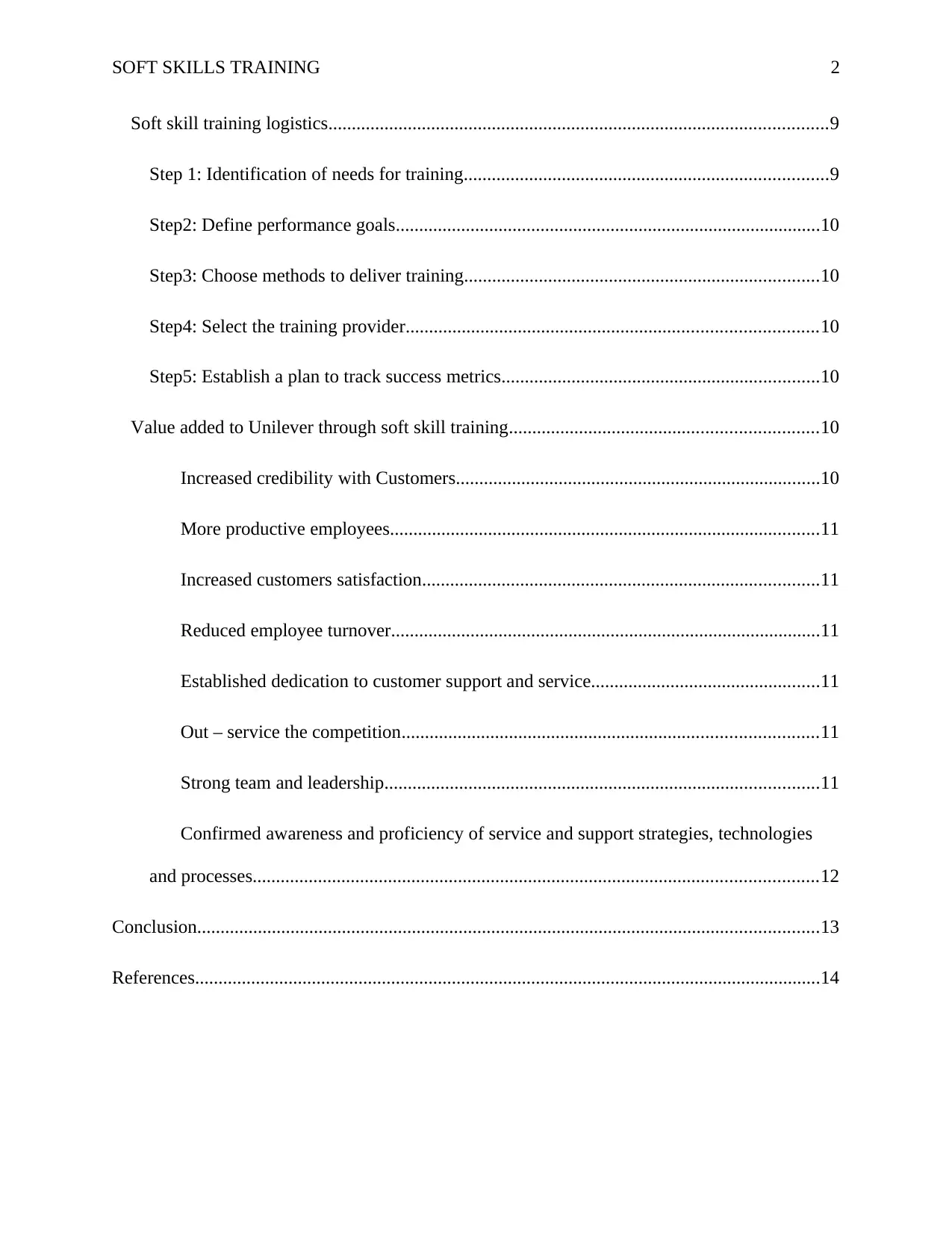
SOFT SKILLS TRAINING 2
Soft skill training logistics...........................................................................................................9
Step 1: Identification of needs for training..............................................................................9
Step2: Define performance goals...........................................................................................10
Step3: Choose methods to deliver training............................................................................10
Step4: Select the training provider........................................................................................10
Step5: Establish a plan to track success metrics....................................................................10
Value added to Unilever through soft skill training..................................................................10
Increased credibility with Customers..............................................................................10
More productive employees............................................................................................11
Increased customers satisfaction.....................................................................................11
Reduced employee turnover............................................................................................11
Established dedication to customer support and service.................................................11
Out – service the competition.........................................................................................11
Strong team and leadership.............................................................................................11
Confirmed awareness and proficiency of service and support strategies, technologies
and processes.........................................................................................................................12
Conclusion.....................................................................................................................................13
References......................................................................................................................................14
Soft skill training logistics...........................................................................................................9
Step 1: Identification of needs for training..............................................................................9
Step2: Define performance goals...........................................................................................10
Step3: Choose methods to deliver training............................................................................10
Step4: Select the training provider........................................................................................10
Step5: Establish a plan to track success metrics....................................................................10
Value added to Unilever through soft skill training..................................................................10
Increased credibility with Customers..............................................................................10
More productive employees............................................................................................11
Increased customers satisfaction.....................................................................................11
Reduced employee turnover............................................................................................11
Established dedication to customer support and service.................................................11
Out – service the competition.........................................................................................11
Strong team and leadership.............................................................................................11
Confirmed awareness and proficiency of service and support strategies, technologies
and processes.........................................................................................................................12
Conclusion.....................................................................................................................................13
References......................................................................................................................................14
⊘ This is a preview!⊘
Do you want full access?
Subscribe today to unlock all pages.

Trusted by 1+ million students worldwide
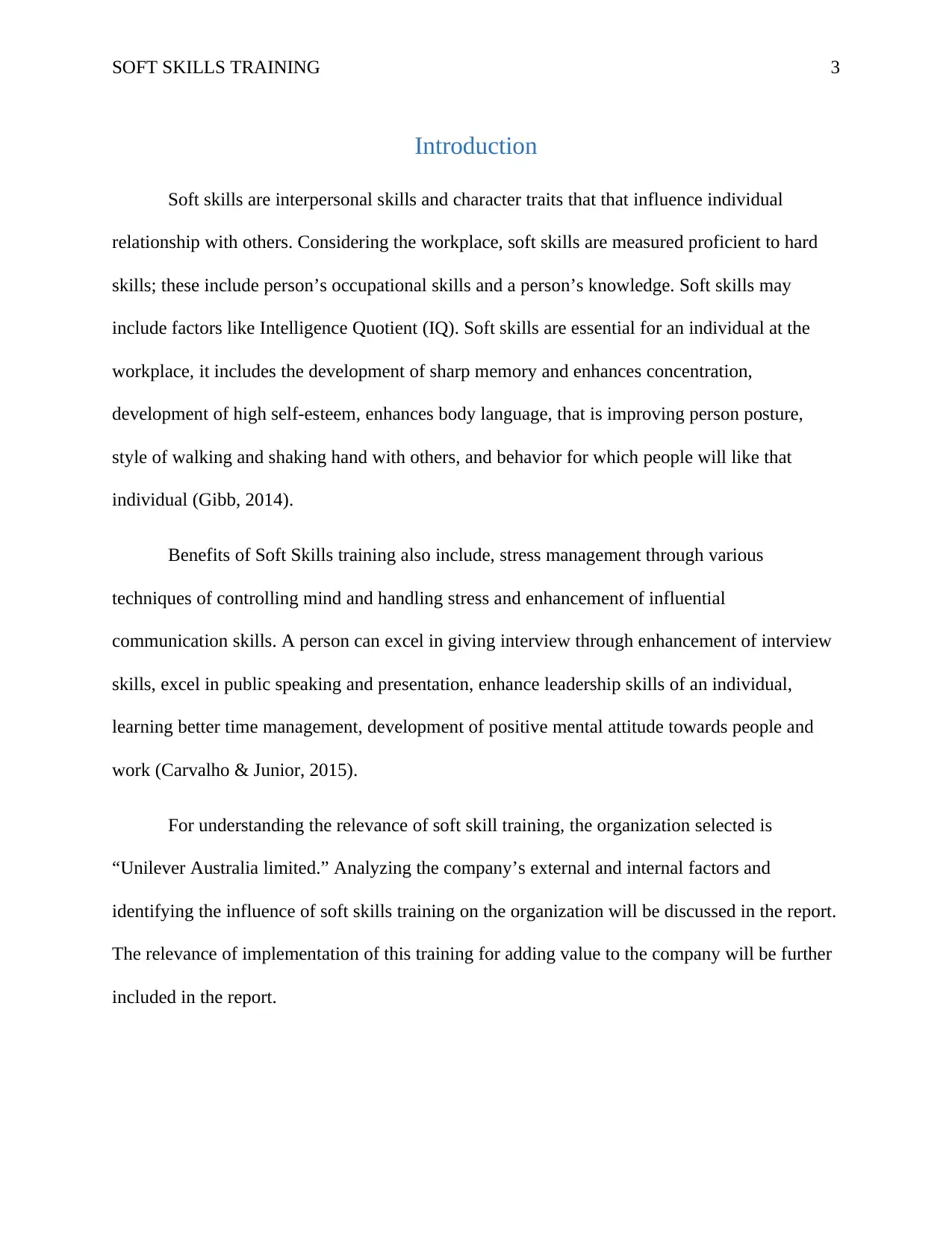
SOFT SKILLS TRAINING 3
Introduction
Soft skills are interpersonal skills and character traits that that influence individual
relationship with others. Considering the workplace, soft skills are measured proficient to hard
skills; these include person’s occupational skills and a person’s knowledge. Soft skills may
include factors like Intelligence Quotient (IQ). Soft skills are essential for an individual at the
workplace, it includes the development of sharp memory and enhances concentration,
development of high self-esteem, enhances body language, that is improving person posture,
style of walking and shaking hand with others, and behavior for which people will like that
individual (Gibb, 2014).
Benefits of Soft Skills training also include, stress management through various
techniques of controlling mind and handling stress and enhancement of influential
communication skills. A person can excel in giving interview through enhancement of interview
skills, excel in public speaking and presentation, enhance leadership skills of an individual,
learning better time management, development of positive mental attitude towards people and
work (Carvalho & Junior, 2015).
For understanding the relevance of soft skill training, the organization selected is
“Unilever Australia limited.” Analyzing the company’s external and internal factors and
identifying the influence of soft skills training on the organization will be discussed in the report.
The relevance of implementation of this training for adding value to the company will be further
included in the report.
Introduction
Soft skills are interpersonal skills and character traits that that influence individual
relationship with others. Considering the workplace, soft skills are measured proficient to hard
skills; these include person’s occupational skills and a person’s knowledge. Soft skills may
include factors like Intelligence Quotient (IQ). Soft skills are essential for an individual at the
workplace, it includes the development of sharp memory and enhances concentration,
development of high self-esteem, enhances body language, that is improving person posture,
style of walking and shaking hand with others, and behavior for which people will like that
individual (Gibb, 2014).
Benefits of Soft Skills training also include, stress management through various
techniques of controlling mind and handling stress and enhancement of influential
communication skills. A person can excel in giving interview through enhancement of interview
skills, excel in public speaking and presentation, enhance leadership skills of an individual,
learning better time management, development of positive mental attitude towards people and
work (Carvalho & Junior, 2015).
For understanding the relevance of soft skill training, the organization selected is
“Unilever Australia limited.” Analyzing the company’s external and internal factors and
identifying the influence of soft skills training on the organization will be discussed in the report.
The relevance of implementation of this training for adding value to the company will be further
included in the report.
Paraphrase This Document
Need a fresh take? Get an instant paraphrase of this document with our AI Paraphraser
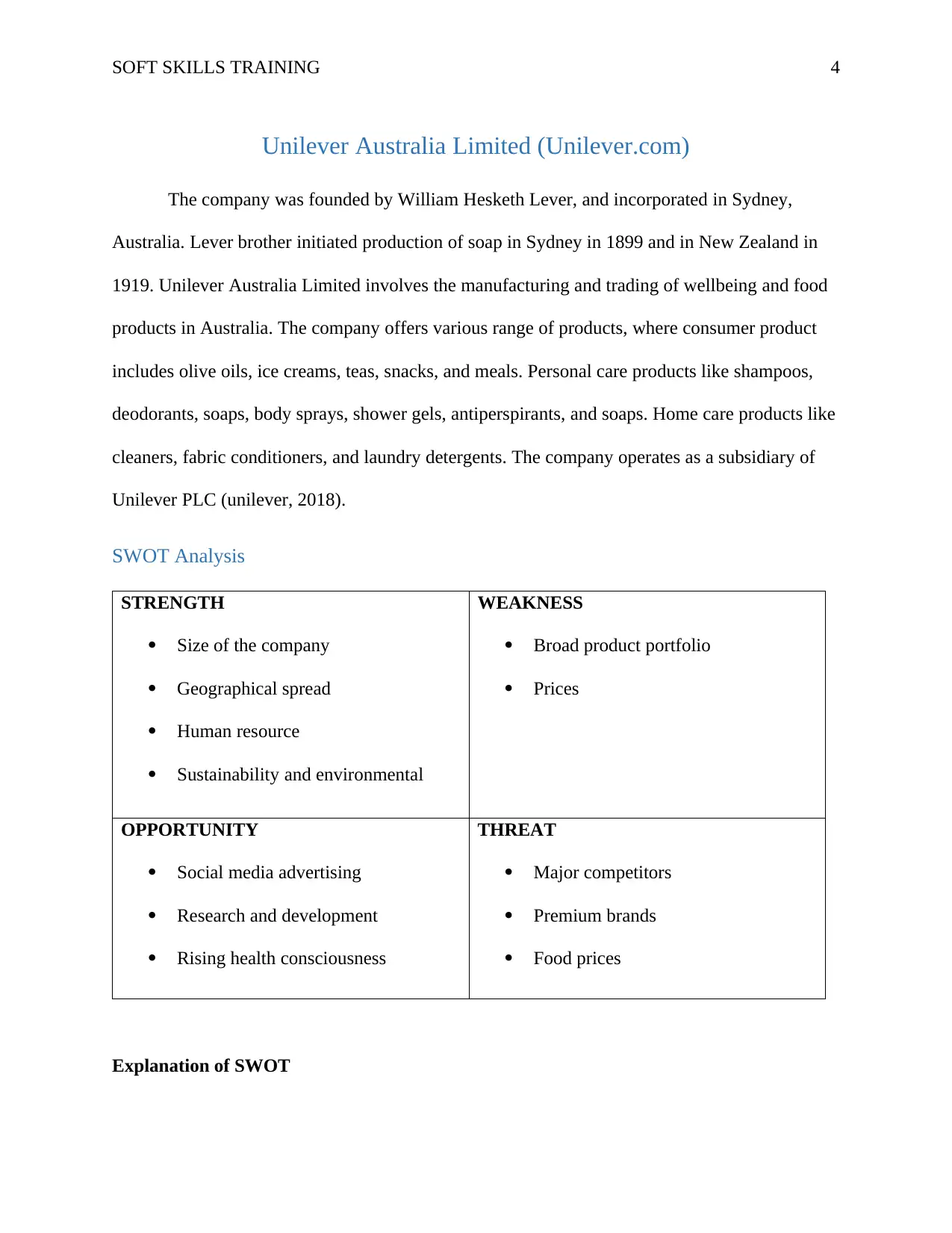
SOFT SKILLS TRAINING 4
Unilever Australia Limited (Unilever.com)
The company was founded by William Hesketh Lever, and incorporated in Sydney,
Australia. Lever brother initiated production of soap in Sydney in 1899 and in New Zealand in
1919. Unilever Australia Limited involves the manufacturing and trading of wellbeing and food
products in Australia. The company offers various range of products, where consumer product
includes olive oils, ice creams, teas, snacks, and meals. Personal care products like shampoos,
deodorants, soaps, body sprays, shower gels, antiperspirants, and soaps. Home care products like
cleaners, fabric conditioners, and laundry detergents. The company operates as a subsidiary of
Unilever PLC (unilever, 2018).
SWOT Analysis
STRENGTH
Size of the company
Geographical spread
Human resource
Sustainability and environmental
WEAKNESS
Broad product portfolio
Prices
OPPORTUNITY
Social media advertising
Research and development
Rising health consciousness
THREAT
Major competitors
Premium brands
Food prices
Explanation of SWOT
Unilever Australia Limited (Unilever.com)
The company was founded by William Hesketh Lever, and incorporated in Sydney,
Australia. Lever brother initiated production of soap in Sydney in 1899 and in New Zealand in
1919. Unilever Australia Limited involves the manufacturing and trading of wellbeing and food
products in Australia. The company offers various range of products, where consumer product
includes olive oils, ice creams, teas, snacks, and meals. Personal care products like shampoos,
deodorants, soaps, body sprays, shower gels, antiperspirants, and soaps. Home care products like
cleaners, fabric conditioners, and laundry detergents. The company operates as a subsidiary of
Unilever PLC (unilever, 2018).
SWOT Analysis
STRENGTH
Size of the company
Geographical spread
Human resource
Sustainability and environmental
WEAKNESS
Broad product portfolio
Prices
OPPORTUNITY
Social media advertising
Research and development
Rising health consciousness
THREAT
Major competitors
Premium brands
Food prices
Explanation of SWOT
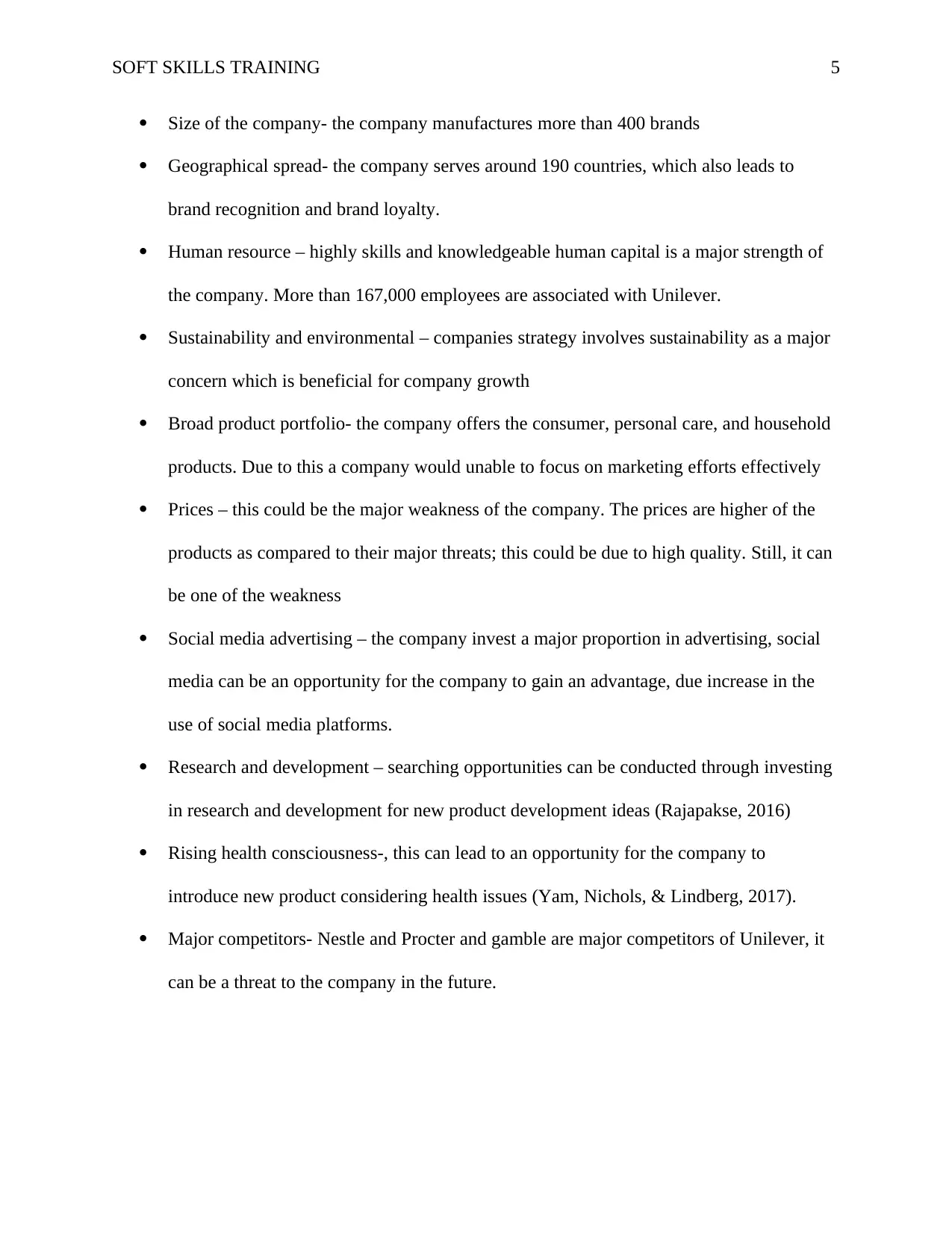
SOFT SKILLS TRAINING 5
Size of the company- the company manufactures more than 400 brands
Geographical spread- the company serves around 190 countries, which also leads to
brand recognition and brand loyalty.
Human resource – highly skills and knowledgeable human capital is a major strength of
the company. More than 167,000 employees are associated with Unilever.
Sustainability and environmental – companies strategy involves sustainability as a major
concern which is beneficial for company growth
Broad product portfolio- the company offers the consumer, personal care, and household
products. Due to this a company would unable to focus on marketing efforts effectively
Prices – this could be the major weakness of the company. The prices are higher of the
products as compared to their major threats; this could be due to high quality. Still, it can
be one of the weakness
Social media advertising – the company invest a major proportion in advertising, social
media can be an opportunity for the company to gain an advantage, due increase in the
use of social media platforms.
Research and development – searching opportunities can be conducted through investing
in research and development for new product development ideas (Rajapakse, 2016)
Rising health consciousness-, this can lead to an opportunity for the company to
introduce new product considering health issues (Yam, Nichols, & Lindberg, 2017).
Major competitors- Nestle and Procter and gamble are major competitors of Unilever, it
can be a threat to the company in the future.
Size of the company- the company manufactures more than 400 brands
Geographical spread- the company serves around 190 countries, which also leads to
brand recognition and brand loyalty.
Human resource – highly skills and knowledgeable human capital is a major strength of
the company. More than 167,000 employees are associated with Unilever.
Sustainability and environmental – companies strategy involves sustainability as a major
concern which is beneficial for company growth
Broad product portfolio- the company offers the consumer, personal care, and household
products. Due to this a company would unable to focus on marketing efforts effectively
Prices – this could be the major weakness of the company. The prices are higher of the
products as compared to their major threats; this could be due to high quality. Still, it can
be one of the weakness
Social media advertising – the company invest a major proportion in advertising, social
media can be an opportunity for the company to gain an advantage, due increase in the
use of social media platforms.
Research and development – searching opportunities can be conducted through investing
in research and development for new product development ideas (Rajapakse, 2016)
Rising health consciousness-, this can lead to an opportunity for the company to
introduce new product considering health issues (Yam, Nichols, & Lindberg, 2017).
Major competitors- Nestle and Procter and gamble are major competitors of Unilever, it
can be a threat to the company in the future.
⊘ This is a preview!⊘
Do you want full access?
Subscribe today to unlock all pages.

Trusted by 1+ million students worldwide
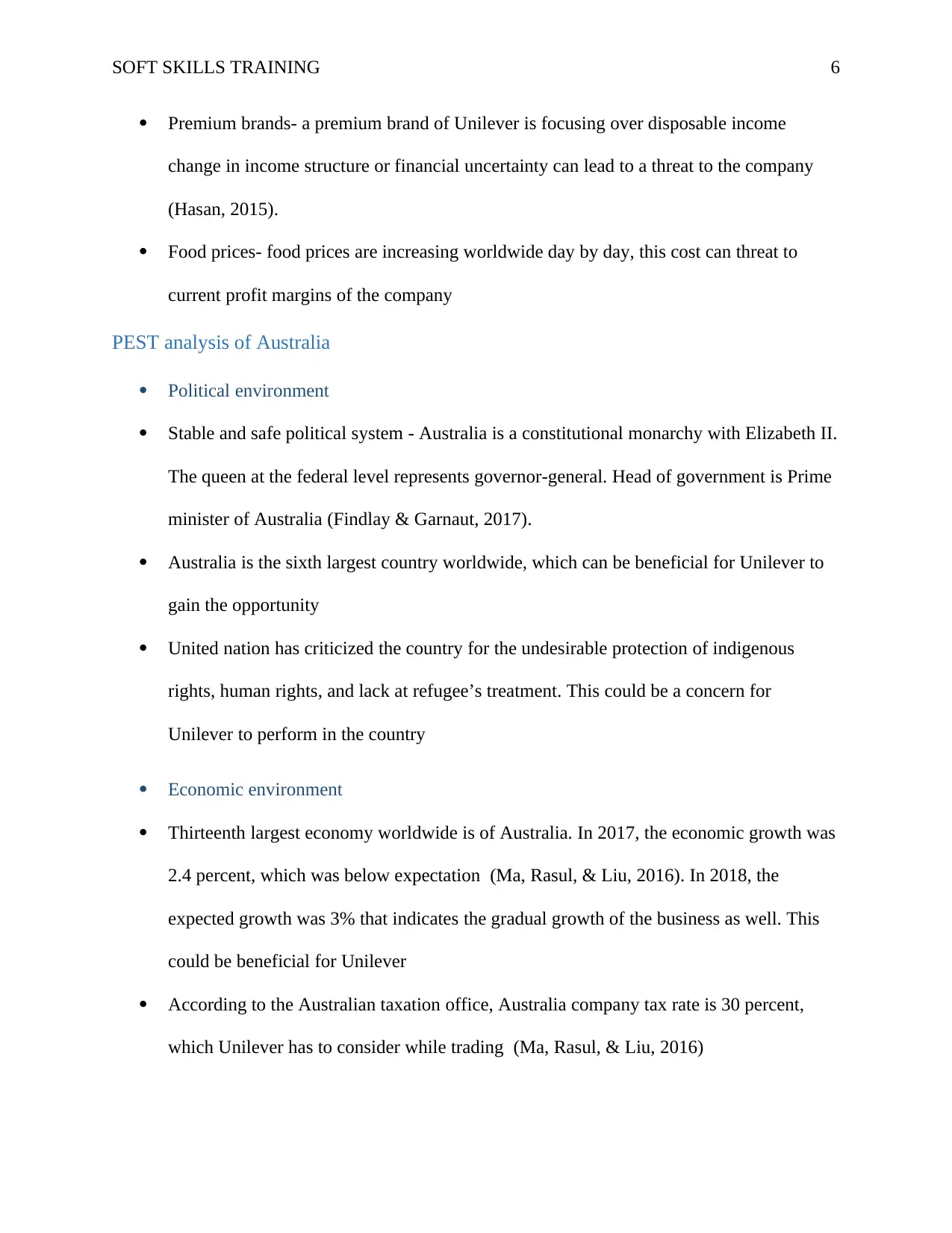
SOFT SKILLS TRAINING 6
Premium brands- a premium brand of Unilever is focusing over disposable income
change in income structure or financial uncertainty can lead to a threat to the company
(Hasan, 2015).
Food prices- food prices are increasing worldwide day by day, this cost can threat to
current profit margins of the company
PEST analysis of Australia
Political environment
Stable and safe political system - Australia is a constitutional monarchy with Elizabeth II.
The queen at the federal level represents governor-general. Head of government is Prime
minister of Australia (Findlay & Garnaut, 2017).
Australia is the sixth largest country worldwide, which can be beneficial for Unilever to
gain the opportunity
United nation has criticized the country for the undesirable protection of indigenous
rights, human rights, and lack at refugee’s treatment. This could be a concern for
Unilever to perform in the country
Economic environment
Thirteenth largest economy worldwide is of Australia. In 2017, the economic growth was
2.4 percent, which was below expectation (Ma, Rasul, & Liu, 2016). In 2018, the
expected growth was 3% that indicates the gradual growth of the business as well. This
could be beneficial for Unilever
According to the Australian taxation office, Australia company tax rate is 30 percent,
which Unilever has to consider while trading (Ma, Rasul, & Liu, 2016)
Premium brands- a premium brand of Unilever is focusing over disposable income
change in income structure or financial uncertainty can lead to a threat to the company
(Hasan, 2015).
Food prices- food prices are increasing worldwide day by day, this cost can threat to
current profit margins of the company
PEST analysis of Australia
Political environment
Stable and safe political system - Australia is a constitutional monarchy with Elizabeth II.
The queen at the federal level represents governor-general. Head of government is Prime
minister of Australia (Findlay & Garnaut, 2017).
Australia is the sixth largest country worldwide, which can be beneficial for Unilever to
gain the opportunity
United nation has criticized the country for the undesirable protection of indigenous
rights, human rights, and lack at refugee’s treatment. This could be a concern for
Unilever to perform in the country
Economic environment
Thirteenth largest economy worldwide is of Australia. In 2017, the economic growth was
2.4 percent, which was below expectation (Ma, Rasul, & Liu, 2016). In 2018, the
expected growth was 3% that indicates the gradual growth of the business as well. This
could be beneficial for Unilever
According to the Australian taxation office, Australia company tax rate is 30 percent,
which Unilever has to consider while trading (Ma, Rasul, & Liu, 2016)
Paraphrase This Document
Need a fresh take? Get an instant paraphrase of this document with our AI Paraphraser
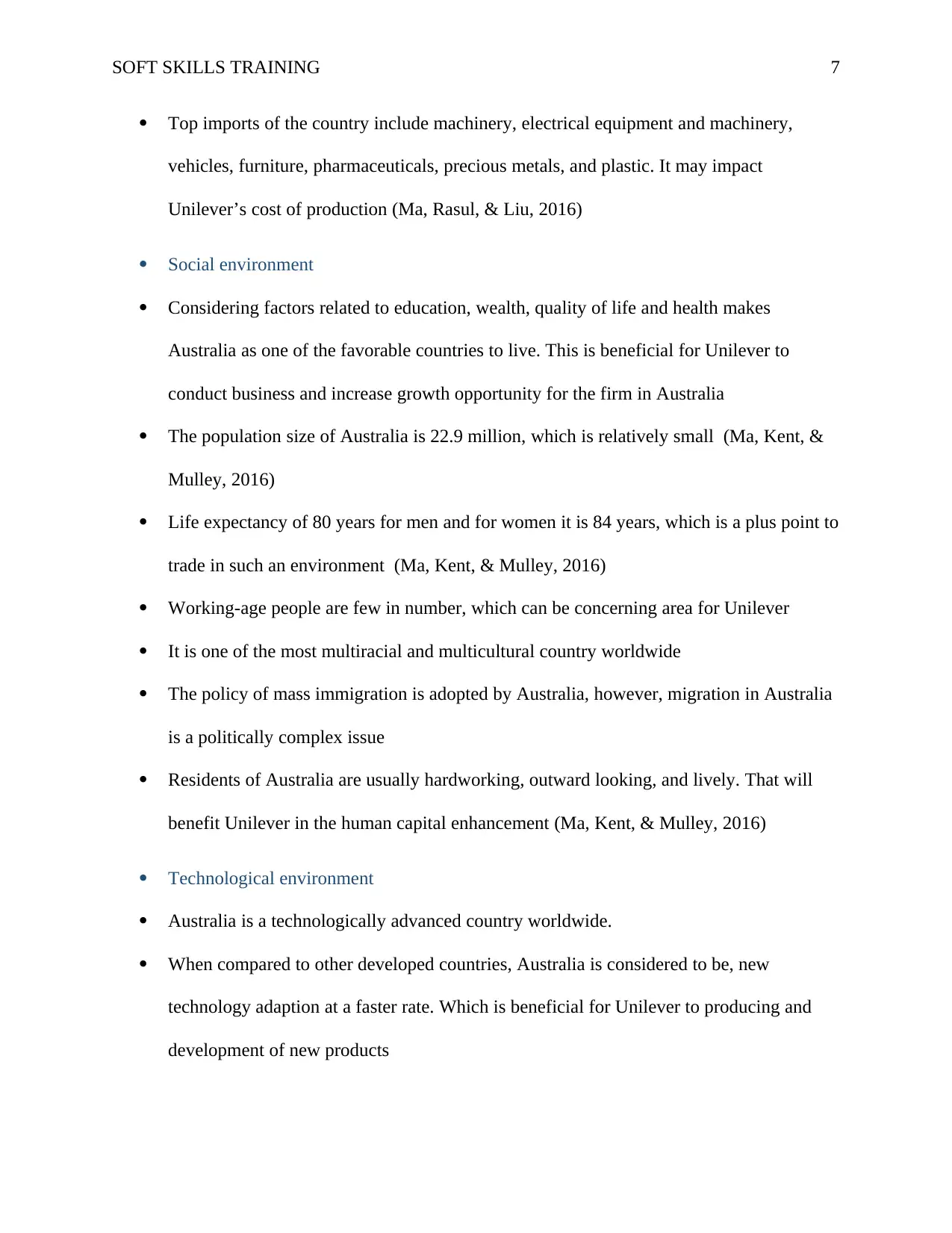
SOFT SKILLS TRAINING 7
Top imports of the country include machinery, electrical equipment and machinery,
vehicles, furniture, pharmaceuticals, precious metals, and plastic. It may impact
Unilever’s cost of production (Ma, Rasul, & Liu, 2016)
Social environment
Considering factors related to education, wealth, quality of life and health makes
Australia as one of the favorable countries to live. This is beneficial for Unilever to
conduct business and increase growth opportunity for the firm in Australia
The population size of Australia is 22.9 million, which is relatively small (Ma, Kent, &
Mulley, 2016)
Life expectancy of 80 years for men and for women it is 84 years, which is a plus point to
trade in such an environment (Ma, Kent, & Mulley, 2016)
Working-age people are few in number, which can be concerning area for Unilever
It is one of the most multiracial and multicultural country worldwide
The policy of mass immigration is adopted by Australia, however, migration in Australia
is a politically complex issue
Residents of Australia are usually hardworking, outward looking, and lively. That will
benefit Unilever in the human capital enhancement (Ma, Kent, & Mulley, 2016)
Technological environment
Australia is a technologically advanced country worldwide.
When compared to other developed countries, Australia is considered to be, new
technology adaption at a faster rate. Which is beneficial for Unilever to producing and
development of new products
Top imports of the country include machinery, electrical equipment and machinery,
vehicles, furniture, pharmaceuticals, precious metals, and plastic. It may impact
Unilever’s cost of production (Ma, Rasul, & Liu, 2016)
Social environment
Considering factors related to education, wealth, quality of life and health makes
Australia as one of the favorable countries to live. This is beneficial for Unilever to
conduct business and increase growth opportunity for the firm in Australia
The population size of Australia is 22.9 million, which is relatively small (Ma, Kent, &
Mulley, 2016)
Life expectancy of 80 years for men and for women it is 84 years, which is a plus point to
trade in such an environment (Ma, Kent, & Mulley, 2016)
Working-age people are few in number, which can be concerning area for Unilever
It is one of the most multiracial and multicultural country worldwide
The policy of mass immigration is adopted by Australia, however, migration in Australia
is a politically complex issue
Residents of Australia are usually hardworking, outward looking, and lively. That will
benefit Unilever in the human capital enhancement (Ma, Kent, & Mulley, 2016)
Technological environment
Australia is a technologically advanced country worldwide.
When compared to other developed countries, Australia is considered to be, new
technology adaption at a faster rate. Which is beneficial for Unilever to producing and
development of new products
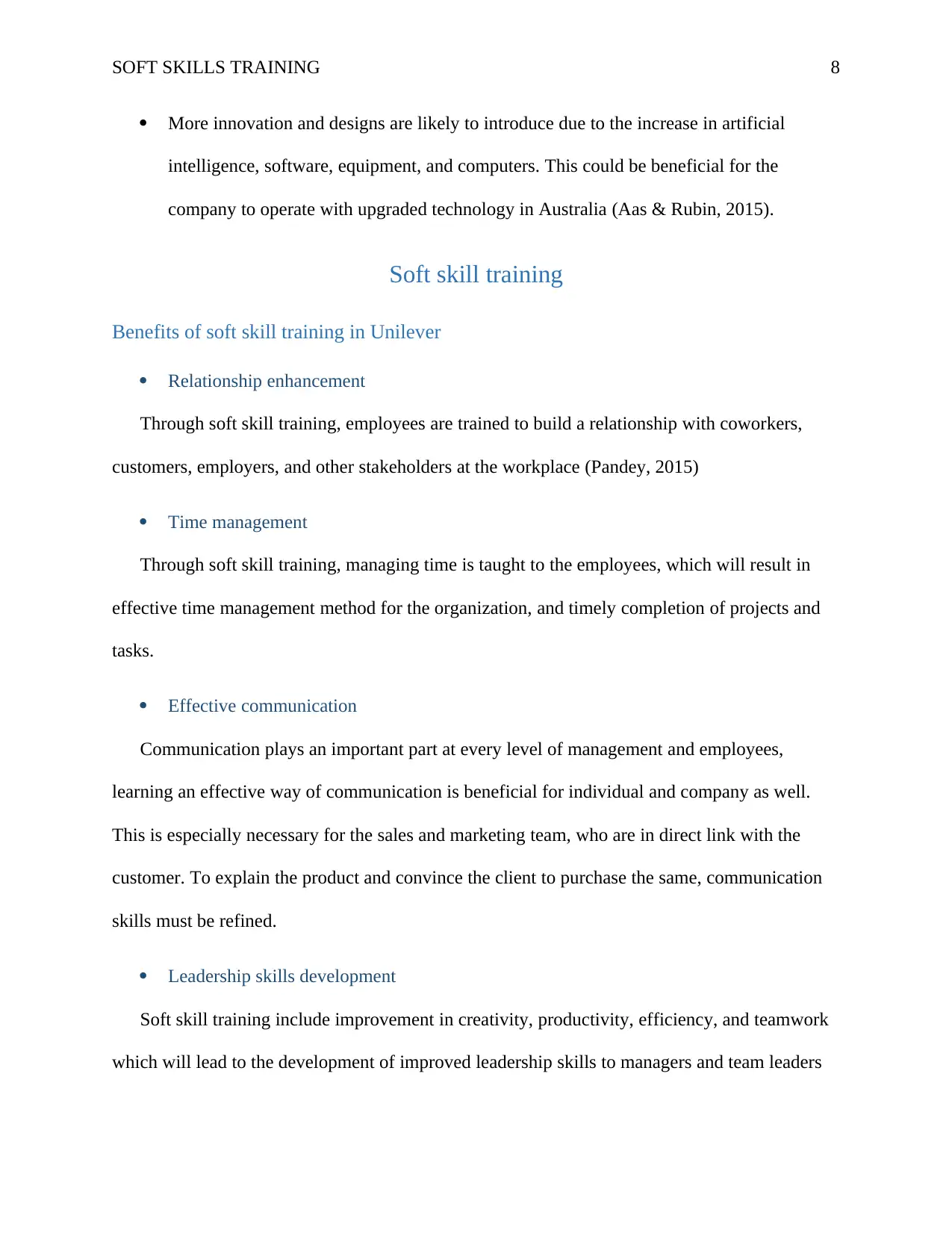
SOFT SKILLS TRAINING 8
More innovation and designs are likely to introduce due to the increase in artificial
intelligence, software, equipment, and computers. This could be beneficial for the
company to operate with upgraded technology in Australia (Aas & Rubin, 2015).
Soft skill training
Benefits of soft skill training in Unilever
Relationship enhancement
Through soft skill training, employees are trained to build a relationship with coworkers,
customers, employers, and other stakeholders at the workplace (Pandey, 2015)
Time management
Through soft skill training, managing time is taught to the employees, which will result in
effective time management method for the organization, and timely completion of projects and
tasks.
Effective communication
Communication plays an important part at every level of management and employees,
learning an effective way of communication is beneficial for individual and company as well.
This is especially necessary for the sales and marketing team, who are in direct link with the
customer. To explain the product and convince the client to purchase the same, communication
skills must be refined.
Leadership skills development
Soft skill training include improvement in creativity, productivity, efficiency, and teamwork
which will lead to the development of improved leadership skills to managers and team leaders
More innovation and designs are likely to introduce due to the increase in artificial
intelligence, software, equipment, and computers. This could be beneficial for the
company to operate with upgraded technology in Australia (Aas & Rubin, 2015).
Soft skill training
Benefits of soft skill training in Unilever
Relationship enhancement
Through soft skill training, employees are trained to build a relationship with coworkers,
customers, employers, and other stakeholders at the workplace (Pandey, 2015)
Time management
Through soft skill training, managing time is taught to the employees, which will result in
effective time management method for the organization, and timely completion of projects and
tasks.
Effective communication
Communication plays an important part at every level of management and employees,
learning an effective way of communication is beneficial for individual and company as well.
This is especially necessary for the sales and marketing team, who are in direct link with the
customer. To explain the product and convince the client to purchase the same, communication
skills must be refined.
Leadership skills development
Soft skill training include improvement in creativity, productivity, efficiency, and teamwork
which will lead to the development of improved leadership skills to managers and team leaders
⊘ This is a preview!⊘
Do you want full access?
Subscribe today to unlock all pages.

Trusted by 1+ million students worldwide
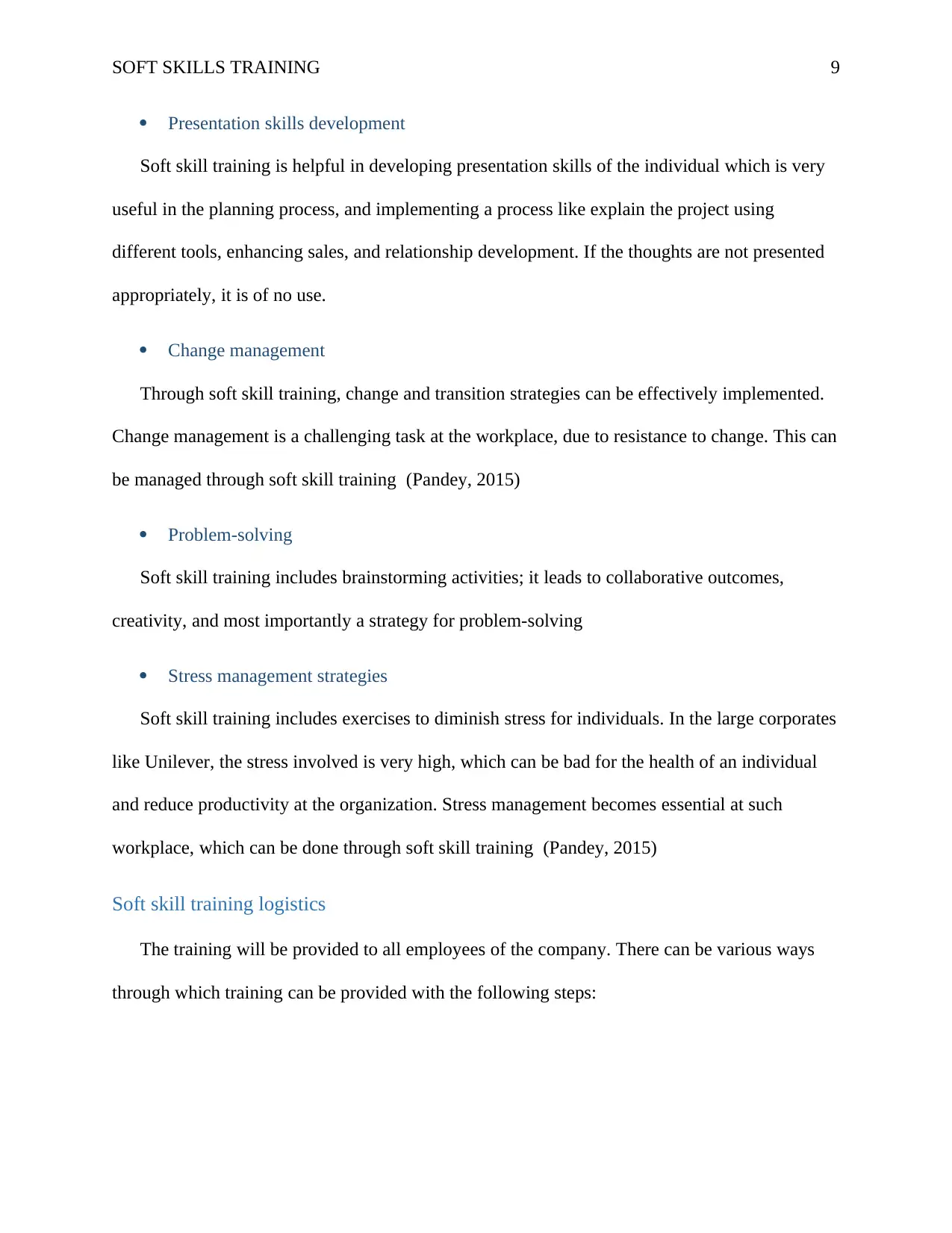
SOFT SKILLS TRAINING 9
Presentation skills development
Soft skill training is helpful in developing presentation skills of the individual which is very
useful in the planning process, and implementing a process like explain the project using
different tools, enhancing sales, and relationship development. If the thoughts are not presented
appropriately, it is of no use.
Change management
Through soft skill training, change and transition strategies can be effectively implemented.
Change management is a challenging task at the workplace, due to resistance to change. This can
be managed through soft skill training (Pandey, 2015)
Problem-solving
Soft skill training includes brainstorming activities; it leads to collaborative outcomes,
creativity, and most importantly a strategy for problem-solving
Stress management strategies
Soft skill training includes exercises to diminish stress for individuals. In the large corporates
like Unilever, the stress involved is very high, which can be bad for the health of an individual
and reduce productivity at the organization. Stress management becomes essential at such
workplace, which can be done through soft skill training (Pandey, 2015)
Soft skill training logistics
The training will be provided to all employees of the company. There can be various ways
through which training can be provided with the following steps:
Presentation skills development
Soft skill training is helpful in developing presentation skills of the individual which is very
useful in the planning process, and implementing a process like explain the project using
different tools, enhancing sales, and relationship development. If the thoughts are not presented
appropriately, it is of no use.
Change management
Through soft skill training, change and transition strategies can be effectively implemented.
Change management is a challenging task at the workplace, due to resistance to change. This can
be managed through soft skill training (Pandey, 2015)
Problem-solving
Soft skill training includes brainstorming activities; it leads to collaborative outcomes,
creativity, and most importantly a strategy for problem-solving
Stress management strategies
Soft skill training includes exercises to diminish stress for individuals. In the large corporates
like Unilever, the stress involved is very high, which can be bad for the health of an individual
and reduce productivity at the organization. Stress management becomes essential at such
workplace, which can be done through soft skill training (Pandey, 2015)
Soft skill training logistics
The training will be provided to all employees of the company. There can be various ways
through which training can be provided with the following steps:
Paraphrase This Document
Need a fresh take? Get an instant paraphrase of this document with our AI Paraphraser
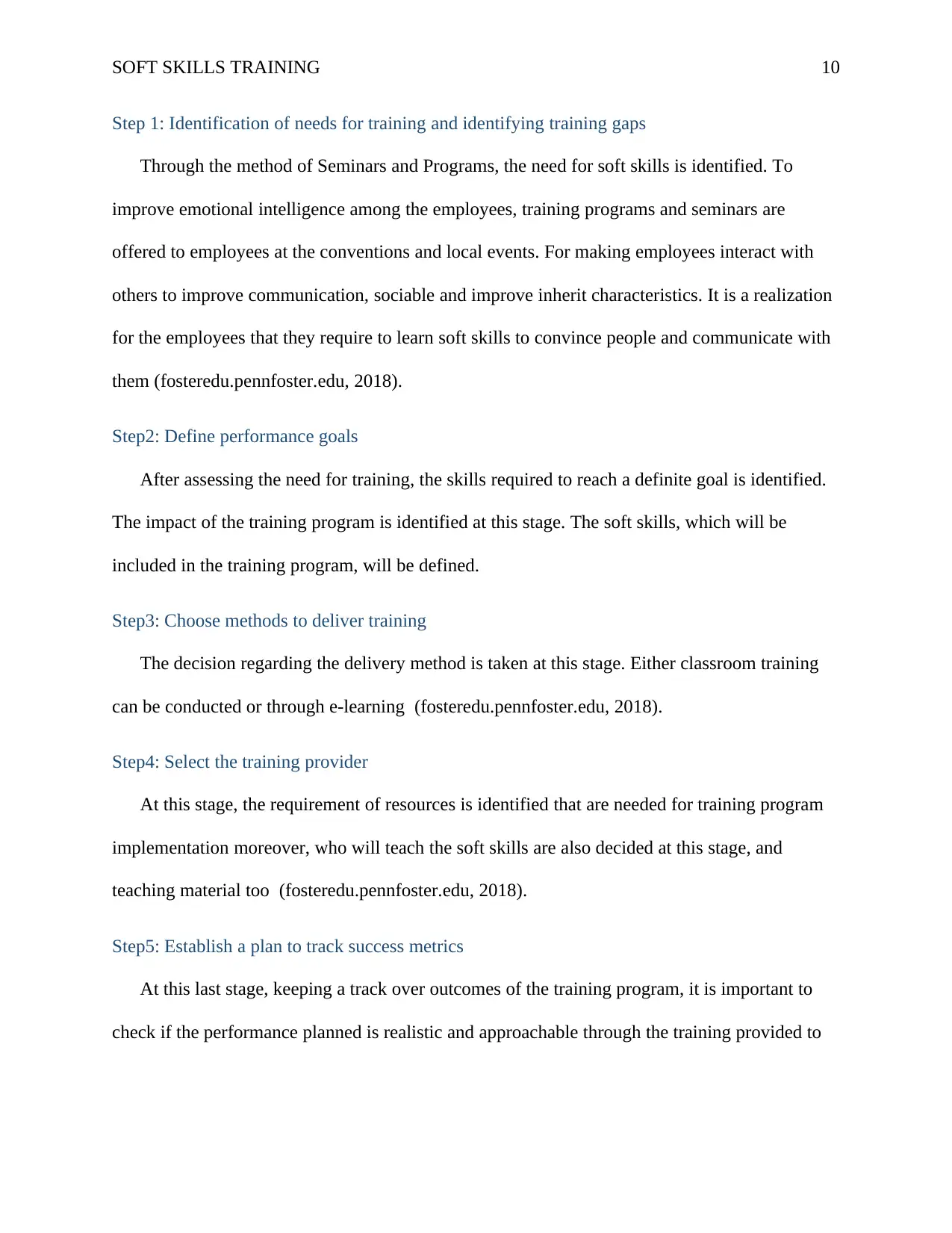
SOFT SKILLS TRAINING 10
Step 1: Identification of needs for training and identifying training gaps
Through the method of Seminars and Programs, the need for soft skills is identified. To
improve emotional intelligence among the employees, training programs and seminars are
offered to employees at the conventions and local events. For making employees interact with
others to improve communication, sociable and improve inherit characteristics. It is a realization
for the employees that they require to learn soft skills to convince people and communicate with
them (fosteredu.pennfoster.edu, 2018).
Step2: Define performance goals
After assessing the need for training, the skills required to reach a definite goal is identified.
The impact of the training program is identified at this stage. The soft skills, which will be
included in the training program, will be defined.
Step3: Choose methods to deliver training
The decision regarding the delivery method is taken at this stage. Either classroom training
can be conducted or through e-learning (fosteredu.pennfoster.edu, 2018).
Step4: Select the training provider
At this stage, the requirement of resources is identified that are needed for training program
implementation moreover, who will teach the soft skills are also decided at this stage, and
teaching material too (fosteredu.pennfoster.edu, 2018).
Step5: Establish a plan to track success metrics
At this last stage, keeping a track over outcomes of the training program, it is important to
check if the performance planned is realistic and approachable through the training provided to
Step 1: Identification of needs for training and identifying training gaps
Through the method of Seminars and Programs, the need for soft skills is identified. To
improve emotional intelligence among the employees, training programs and seminars are
offered to employees at the conventions and local events. For making employees interact with
others to improve communication, sociable and improve inherit characteristics. It is a realization
for the employees that they require to learn soft skills to convince people and communicate with
them (fosteredu.pennfoster.edu, 2018).
Step2: Define performance goals
After assessing the need for training, the skills required to reach a definite goal is identified.
The impact of the training program is identified at this stage. The soft skills, which will be
included in the training program, will be defined.
Step3: Choose methods to deliver training
The decision regarding the delivery method is taken at this stage. Either classroom training
can be conducted or through e-learning (fosteredu.pennfoster.edu, 2018).
Step4: Select the training provider
At this stage, the requirement of resources is identified that are needed for training program
implementation moreover, who will teach the soft skills are also decided at this stage, and
teaching material too (fosteredu.pennfoster.edu, 2018).
Step5: Establish a plan to track success metrics
At this last stage, keeping a track over outcomes of the training program, it is important to
check if the performance planned is realistic and approachable through the training provided to
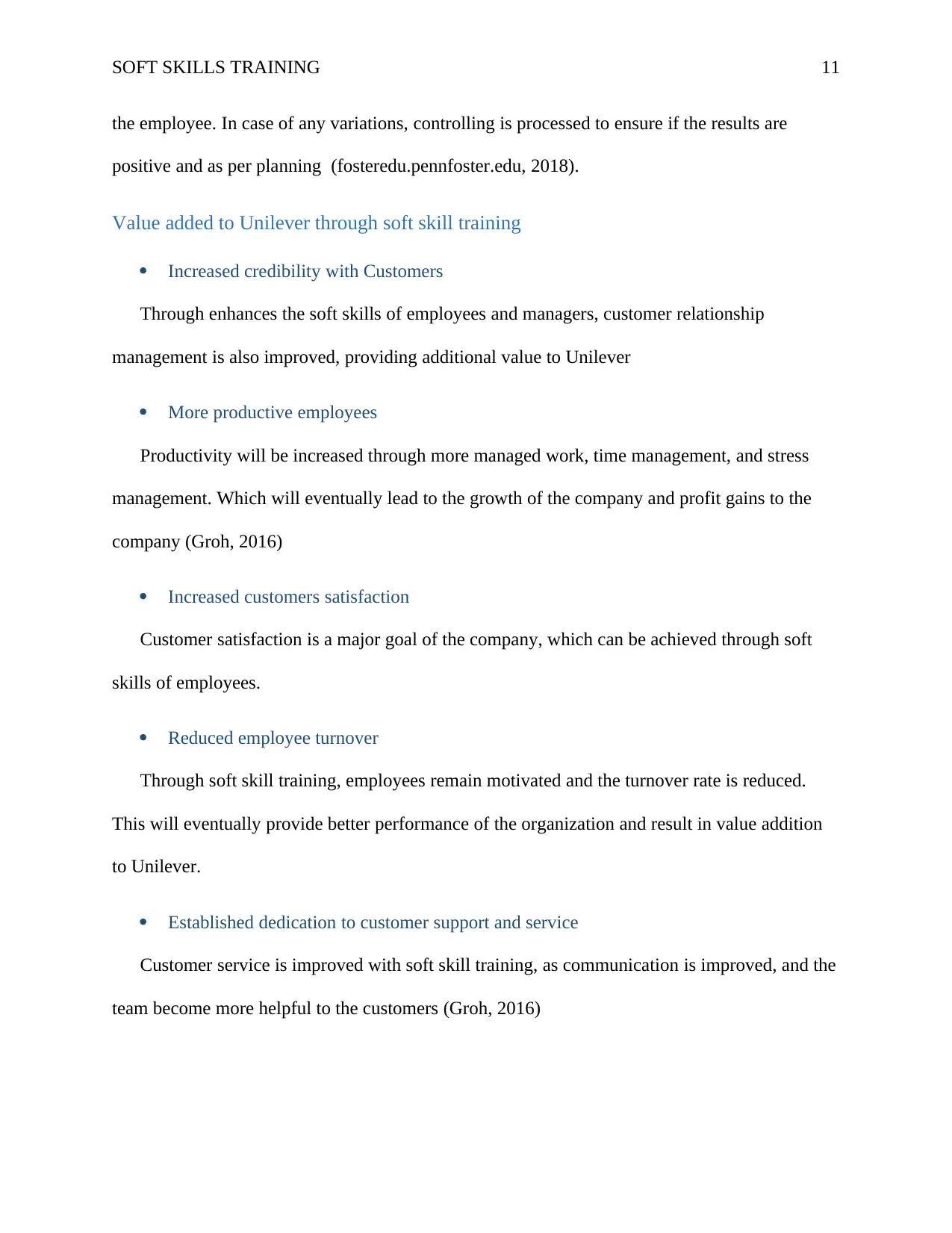
SOFT SKILLS TRAINING 11
the employee. In case of any variations, controlling is processed to ensure if the results are
positive and as per planning (fosteredu.pennfoster.edu, 2018).
Value added to Unilever through soft skill training
Increased credibility with Customers
Through enhances the soft skills of employees and managers, customer relationship
management is also improved, providing additional value to Unilever
More productive employees
Productivity will be increased through more managed work, time management, and stress
management. Which will eventually lead to the growth of the company and profit gains to the
company (Groh, 2016)
Increased customers satisfaction
Customer satisfaction is a major goal of the company, which can be achieved through soft
skills of employees.
Reduced employee turnover
Through soft skill training, employees remain motivated and the turnover rate is reduced.
This will eventually provide better performance of the organization and result in value addition
to Unilever.
Established dedication to customer support and service
Customer service is improved with soft skill training, as communication is improved, and the
team become more helpful to the customers (Groh, 2016)
the employee. In case of any variations, controlling is processed to ensure if the results are
positive and as per planning (fosteredu.pennfoster.edu, 2018).
Value added to Unilever through soft skill training
Increased credibility with Customers
Through enhances the soft skills of employees and managers, customer relationship
management is also improved, providing additional value to Unilever
More productive employees
Productivity will be increased through more managed work, time management, and stress
management. Which will eventually lead to the growth of the company and profit gains to the
company (Groh, 2016)
Increased customers satisfaction
Customer satisfaction is a major goal of the company, which can be achieved through soft
skills of employees.
Reduced employee turnover
Through soft skill training, employees remain motivated and the turnover rate is reduced.
This will eventually provide better performance of the organization and result in value addition
to Unilever.
Established dedication to customer support and service
Customer service is improved with soft skill training, as communication is improved, and the
team become more helpful to the customers (Groh, 2016)
⊘ This is a preview!⊘
Do you want full access?
Subscribe today to unlock all pages.

Trusted by 1+ million students worldwide
1 out of 16
Related Documents
Your All-in-One AI-Powered Toolkit for Academic Success.
+13062052269
info@desklib.com
Available 24*7 on WhatsApp / Email
![[object Object]](/_next/static/media/star-bottom.7253800d.svg)
Unlock your academic potential
Copyright © 2020–2025 A2Z Services. All Rights Reserved. Developed and managed by ZUCOL.





